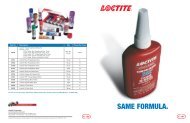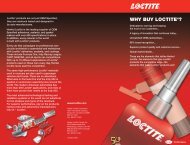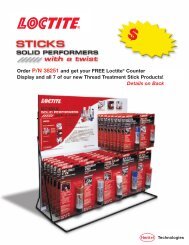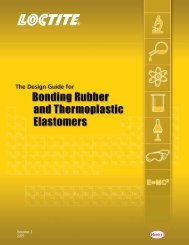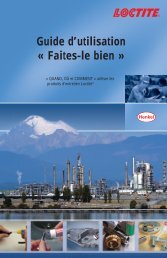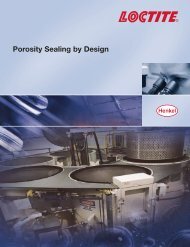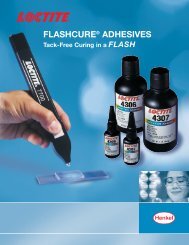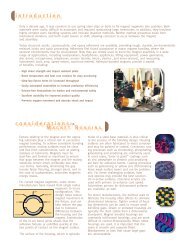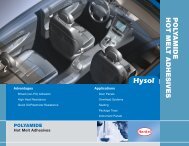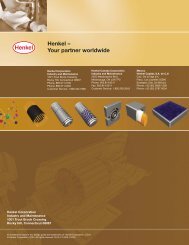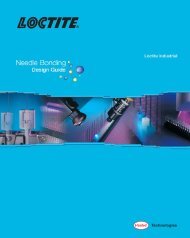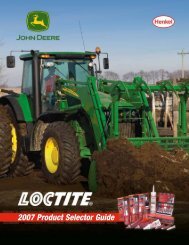Acrylonitrile-Butadiene-Styrene (ABS)ThermoplasticTrade Names• Cevian• Cycolac• Lustran• Magnum• Shinko-Lac• Taitalac• ToyolacManufacturerHoescht CelaneseGeneral ElectricMonsanto ChemicalDow ChemicalMitsubishi RayonTaita Chemical Co.Toray IndustriesGeneral DescriptionABS is a generic name for a versatile family of amor<strong>ph</strong>ous thermoplasticsproduced by combining three monomers, acrylonitrile, butadiene, andstyrene. The ratio of these monomers, as well as the molecular structure,can be manipulated to optimize the characteristics of the resultingpolymer. Acrylonitrile contributes chemical resistance and thermalstability. Butadiene contributes product toughness, impact resistance,and property retention at low temperatures. Styrene contributes rigidity,surface appearance, and processability. The resultant polymer’sproperties can vary over a large range to suit the manufacturer’s needs.For this reason, ABS is widely used in countless applications throughoutindustry. Specialty grades available include general purpose, glass filled,electroplateable, heat resistant, clear, high and low gloss, structural foam,and flame retardant grades. In 2004, the price of ABS ranged from $1.25to $3.00 per pound at truckload quantities.General PropertiesABS offers an excellent combination of toughness and rigidity at a lowcost. Typical notched impact strength ranges from 0.5 to 12 ft.-lb./in.(2.7 to 64.8 kg cm/cm), while typical tensile modulii range from200,000 to 1,200,000 psi (14,000 to 84,000 kg/cm 2 ). In addition to itstoughness, ABS has a high dimensional stability (which permits tightmold tolerances), a pleasing surface appearance, and is very easy toprocess. ABS is a relatively good electrical insulator and is suitable forsecondary insulating applications. ABS is chemically resistant to acidsand bases, but is not recommended for use with esters, ketones, oraldehydes. ABS has poor resistance to UV exposure, resulting insignificant changes in its appearance and mechanical properties. Toaddress this limitation, there are protective coatings available whichenhance ABS’s resistance to UV degradation. Some grades of ABS arecreated by adding a fourth monomer, such as the addition of al<strong>ph</strong>amethyl styrene to create a heat resistant grade. Clear grades arecreated by adding methyl methacrylate, giving ABS the ability totransmit 75 to 80% of light.Typical Properties ofAcrylonitrile-Butadiene-Styrene (ABS)American EngineeringProcessing Temperature 400°F to 525°F 204°C to 274°CLinear Mold Shrinkage 0.002 to 0.007 in./in. 0.002 to 0.007 cm/cmMelting Point – –Density 63.7 to 79.9 lb./ft. 3 1.02 to 1.28 g/cm 3Tensile Strength, Yield 4.6 to 7.9 lb./in. 2 x 10 3 3.2 to 5.6 kg/cm 2 x 10 2Tensile Strength, Break 4.0 to 12.0 lb./in. 2 x 10 3 2.8 to 8.4 kg/cm 2 x 10 2Elongation, Break 1.0 to 50.0% 1.0 to 50.0%Tensile Modulus 2.0 to 12.0 lb./in. 2 x 10 5 1.4 to 8.4 kg/cm 2 x 10 4Flexural Strength, Yield 6.2 to 20.0 lb./in. 2 x 10 3 4.4 to 14.1 kg/cm 2 x 10 2Flexural Modulus 2.5 to 4.4 lb./in. 2 x 10 5 1.8 to 3.1 kg/cm 2 x 10 4Compressive Strength 6.0 to 17.0 lb./in. 2 x 10 3 4.2 to 12.0 kg/cm 2 x 10 2Izod Notched, R.T. 0.5 to 12.0 ft-lb./in. 2.7 to 64.8 kg cm/cmHardness R95 - R125 Rockwell R96 - R125 RockwellThermal Conductivity 1.2 to 1.6 BTU-in./hr.-ft. 2 -°F 0.17 to 0.23 W/m-°KLinear ThermalExpansionDeflection Temperature@ 264 psiDeflection Temperature@ 66 psiContinuousService Temperature1.1 to 5.7 in./in.-°F x 10 -5 2.0 to 10.3 cm/cm-°C x10 -5Typical Applications• Medical – Piercing pins, clamps, filter casings, stopcocks,check valves, blood dialyzers• Miscellaneous – Appliances, business machines, tele<strong>ph</strong>ones,luggage, power tools, bathtubs, pipe fittings, toys, faucets, showerheads, sporting goods, automotive applicationsSI170°F to 240°F 77°C to 116°C190°F to 245°F 88°C to 118°C130°F to 180°F 54°C to 82°CDielectric Strength 350 to 500 V/10 -3 in. 1.4 to 2.0 V/mm x 10 4Dielectric Constant@ 1 MHzDissipation Factor@ 1 MHzWater Absorption,24 hr.3.1 to 3.4 3.1 to 3.40.008 to 0.009 0.008 to 0.0090.1 to 0.5% 0.1 to 0.5%20The <strong>Loctite</strong> ® Design Guide for Bonding Plastics, <strong>Volume</strong> 4
ADHESIVE SHEAR STRENGTH(psi)(MPa)Acryonitrile-Butadiene-StyreneUNFILLED RESIN3 rmsROUGHENED48 rmsANTIOXIDANT0.1% Irga<strong>ph</strong>os 1680.16% Irganox 2450.04% Irganox 1076UV STABILIZER0.4% UV54110.4% UV33460.1% Irganox 1076FLAME RETARDANT13.5% DE83R3% Chlorez 700S4% 772VHT Sb OxideSMOKESUPPRESSANT55 Firebrake ZBZinc BorateLUBRICANT0.2% N,N'-EthyleneBisstearamideGLASS FILLER20% Type 3540Glass FillerCOLORANT4% 7526 ColorantANTISTATIC3% Armostat 550Cyclone GPM 6300 produced by GE Plastics<strong>Loctite</strong> ® 380 Black Max ® Instant Adhesive,Rubber Toughened<strong>Loctite</strong> ® 401 Prism ® Instant Adhesive,Surface InsensitiveMEDICAL: <strong>Loctite</strong> ® 4011 Prism ® Instant Adhesive,Surface Insensitive<strong>Loctite</strong> ® 401 Prism ®<strong>Loctite</strong> ® 770 Prism ® PrimerMEDICAL: <strong>Loctite</strong> ® 4011 Prism ® /<strong>Loctite</strong> ® 7701 Prism ® Primer<strong>Loctite</strong> ® 414 Super Bonder ® Instant Adhesive,General Purpose<strong>Loctite</strong> ® 330 Depend ® Adhesive,Two-Part No-Mix Acrylic<strong>Loctite</strong> ® 3105 Light Cure Adhesive,MEDICAL: <strong>Loctite</strong> ® 3311 Light Cure Adhesive<strong>Loctite</strong> ® 3340 Light Cure Adhesive,UV Cationic Epoxy<strong>Loctite</strong> ® 4305 Flashcure ® Light Cure AdhesiveFLUORESCENT: <strong>Loctite</strong> ® 4307 Flashcure ®Light Cure Adhesive<strong>Loctite</strong> ® H3000 Speedbonder Structural Adhesive, General Purpose<strong>Loctite</strong> ® H4500 Speedbonder Structural Adhesive, Metal Bonder<strong>Loctite</strong> ® 3030 Adhesive, Polyolefin Bonder<strong>Loctite</strong> ® E-00CL Hysol ® Epoxy Adhesive,Low Odor<strong>Loctite</strong> ® E-90FL Hysol ® Epoxy Adhesive,Flexible<strong>Loctite</strong> ® E-30CL Hysol ® Epoxy Adhesive,Glass BonderMEDICAL: <strong>Loctite</strong> ® M-31CL Hysol ®Epoxy Adhesive, Glass Bonder<strong>Loctite</strong> ® E-20HP Hysol ® Epoxy Adhesive,Fast SettingMEDICAL: <strong>Loctite</strong> ® M-21HP Hysol ®Epoxy Adhesive, Fast Setting<strong>Loctite</strong> ® E-214HP Hysol ® Epoxy Adhesive,High Strength<strong>Loctite</strong> ® Fixmaster ® High Performance Epoxy<strong>Loctite</strong> ® 1942 Hysol ® Hot Melt Adhesive,EVA Based<strong>Loctite</strong> ® 3651 Hysol ® Hot Melt Adhesive,Polyolefin<strong>Loctite</strong> ® 7804 Hysol ® Hot Melt Adhesive<strong>Loctite</strong> ® 3631 Hysol ® Hot Melt Adhesive,Urethane<strong>Loctite</strong> ® U-05FL Hysol ® Urethane Adhesive,High Strength<strong>Loctite</strong> ® Fixmaster ® Rapid Rubber RepairOEM: <strong>Loctite</strong> ® U-04FL Hysol ®Urethane Adhesive, Fast Setting<strong>Loctite</strong> ® 5900 ® Flange Sealant,Heavy Body RTV Silicone9506.614009.79506.69506.69506.66504.59506.69506.69506.6>3500 >24.1 >3500 >3500 >3500 >3500 >3500 >3500 >3500 >3500 >3500 >3500 >24.1 >24.1 >24.1 >24.1 >24.1 >24.1 >24.1 >24.1 >24.1 >24.1 >3350 † >3350 † >3350 † >3350 † >3350 † >3350 † >3350 † >3350 † >3350 † >3350 †>23.1 † >23.1 † >23.1 † >23.1 † >23.1 † >23.1 † >23.1 † >23.1 † >23.1 † >23.1 †>3500 >3500 >3500 >3500 >3500 >3500 >3500 >3500 >3500 >3500 >24.1 >24.1 >24.1 >24.1 >24.1 >24.1 >24.1 >24.1 >24.1 >24.1 3002.113009.01501.03002.13002.1>3500 † >3500 † >3500 † >3500 † >3500 † >3500 † >3500 † >3500 † >3500 † >3500 †>24.1 † >24.1 † >24.1 † >24.1 † >24.1 † >24.1 † >24.1 † >24.1 † >24.1 † >24.1 †5503.8>7650 >32.0 170011.78005.5200013.84503.1350024.2180012.4265018.3NOTTESTED8505.92001.41000.7500.3195013.56004.12501.72001.4Adhesive Performance<strong>Loctite</strong> ® 401 Prism ® and 414 Super Bonder ® Instant Adhesives and <strong>Loctite</strong> ® 4305 Flashcure ® and3105 Light Cure Adhesives created bonds that were stronger than the ABS substrate. The bond strengthsachieved by <strong>Loctite</strong> ® H3000 and H4500 Speedbonder Structural Adhesives, 3030 Adhesive, <strong>Loctite</strong> ®E-90FL and E-20HP Hysol ® Epoxy Adhesives, and <strong>Loctite</strong> ® 3631 Hysol ® Hot Melt Adhesive did notachieved substrate failure but performed exceptionally well. However, the addition of an antistatic agentresulted in a large, statistically significant increase in the bond strengths achieved on ABS. <strong>Loctite</strong> ® 1942 Hysol ® and <strong>Loctite</strong> ® 7804 Hysol ® Hot Melt Adhesives consistently achieved the lowest bond strengths.Surface TreatmentsSurface roughening caused a statistically significant increase in the bond strengths achieved when using<strong>Loctite</strong> ® 380 Black Max ® Instant Adhesive and <strong>Loctite</strong> ® 330 Depend ® Adhesive. The effect of surfaceroughening could not be determined for <strong>Loctite</strong> ® 401 Prism ® , 4011 Prism ® and 414 Super Bonder ®Instant Adhesives and <strong>Loctite</strong> ® 3105 and 3311 Light Cure Adhesives because the bonds created by theseadhesives were stronger than the ABS substrate for both the treated and untreated ABS. Likewise, the effectof using <strong>Loctite</strong> ® 770 Prism ® Primer, in conjunction with <strong>Loctite</strong> ® 401 Prism ® Instant Adhesive, or <strong>Loctite</strong> ®4011 Prism ® Medical Device Instant Adhesive with <strong>Loctite</strong> ® 7701 Prism ® Primer, could not be determined.Other Important Information• ABS can be stress cracked by uncured cyanoacrylate adhesives, so any excess adhesiveshould be removed from the surface immediately.• ABS is compatible with acrylic adhesives, but can be attacked by their activators beforethe adhesive has cured. Any excess activator should be removed from the surface immediately.• ABS is incompatible with anaerobic adhesives.• Surface cleaners: isopropyl alcohol, <strong>Loctite</strong> ® ODC-Free Cleaner & Degreaser.NOTES: The force applied to the tests specimens exceededthe strength of the material resulting in substrate failurebefore the actual bond strength achieved by theadhesive could be determined.† Due to the severe deformation of the block shearspecimens, testing was stopped before the actual bondstrength achieved by the adhesive could be determined(the adhesive bond never failed).3002.13002.13002.13002.1NOT TESTED: Substrate melted at adhesivecure temperature.3002.1The addition of the indicated additive (or surfaceroughening) caused a statistically significant decrease inthe bond strength within 95% confidence limits.The addition of the indicated additive (or surfaceroughening) caused a statistically significant increasein the bond strength within 95% confidence limits.The <strong>Loctite</strong> ® Design Guide for Bonding Plastics, <strong>Volume</strong> 4 21



